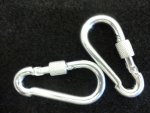I leave the more serious questions for the experienced,but since you HAVE to check traps every 24 hours…maybe you could lay big Landscaping/Walkway stones over them when you are gone? That & a small tree laid over the top,to camouflage it & further keep animals from digging to it? Gotta do something like that,or take them up 


